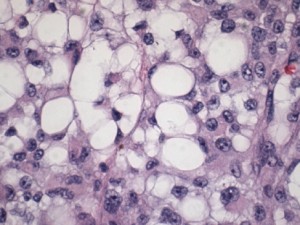Signet ring cell melanoma, also known as signet ring cell melanoma, is a rare histological variant of cutaneous melanoma. The term “signet ring” derives from the distinctive appearance of tumor cells, which exhibit large vacuolated cytoplasm that displaces the nucleus to the periphery of the cell, resembling the shape of a signet ring.
This variant of melanoma is mainly divided into two types:
- A more common form with polygonal cells presenting an accumulation of vimentin filaments in the cytoplasm and a nucleus located at the periphery with a semilunar morphology.
- A rarer form with intracytoplasmic vacuoles and an eccentric nucleus, which has a lipoblast-like appearance.
Signet-ring cell melanoma can develop anywhere on the body, but is most commonly found on the skin of the trunk or limbs. This variant of melanoma can occur in all age groups and does not show a gender predilection.
It is an aggressive tumor that tends to progress rapidly and metastasize early. The prognosis for patients with this variant of melanoma is generally worse than for other forms of cutaneous melanoma.
Diagnosis is made through microscopic analysis of a tissue sample obtained by biopsy, which can reveal the presence of atypical melanocytic cells with the specific characteristics of signet ring cells.
Treatment of this form of melanoma is based on surgical excision of the primary lesion and, if necessary, removal of regional lymph nodes. Other treatments, such as chemotherapy, immunotherapy, or radiation therapy, may be used if the disease has spread to other parts of the body.
